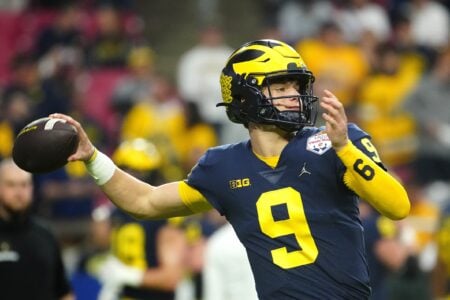drpatriot
Third String But Playing on Special Teams
- Joined
- Nov 13, 2005
- Messages
- 609
- Reaction score
- 0
I'd like to highlight an idea that I wrote about last year but didn't really too much opinion on it. These are two articles that I wrote for ArmchairGM.com last year after the draft, and I thought it would be appropriate to bring them both up again. Keep in mind that these were written last year, and don't have current info or ideas about last year's draft picks.
The Impact of First-Round Picks article will give per-team analysis as opposed to simply listing off teams in each "category".
The Impact of First-Round Picks article will give per-team analysis as opposed to simply listing off teams in each "category".
The Impact of First-Round Picks said:During this dull period between the draft and training camp, I continue to see strong pressure to produce on first-round picks from both fans and the media. This caused me to begin to wonder about how the production of first-round picks actually affected the course of a team’s season. This train of thought spurred an analysis of the first rounds of the draft during recent years to see how well teams have done based on the production of their first-round picks during those years.
After analyzing each team’s first-round picks during this period, I grouped each team’s drafts into five groups. These groups were labeled “Consistently Strong,” “Mediocre,” “Somewhat Inconsistent,” “Very Inconsistent/Poor Decision Making,” and “Consistently Weak.” Teams in each group would have first-round picks from 2000 to 2005 that, overall, played in the way described by the category.
Finally, the team’s record over the course of those six years was calculated and included next to their name. Any conference or Super Bowl championships were also included.
Consistently Strong:
Teams in this group have had solid or better production from all or most of their players. Teams may have had difficulty drafting at a single position but have had excellent production from the rest of their players.
Teams: Baltimore, Dallas, Indianapolis, Jacksonville, New England, Pittsburgh, San Diego, Seattle
Mediocre:
Teams in this category have had good production from most of their draft picks, with some players more or less outstanding than others.
Teams: Carolina, Houston, Kansas City, Minnesota, New Orleans, Philadelphia, Tennessee
Somewhat Inconsistant:
Teams in this group have had varied success in the first round, sometimes drafting Pro Bowlers but drafting busts often as well.
Teams: Atlanta, Buffalo, Denver, Green Bay, New York Giants
Very Inconsistant/Poor Decision Making:
Teams in this group have drafted more busts than star players or have otherwise made poor decisions on their draft choices.
Teams: Chicago, Cincinnati, New York Jets, St. Louis, Washington
Consistently Weak:
Teams in this category have had little production from most or all of their 1st-round draft picks during the six-year time period.
Teams: Arizona, Cleveland, Detroit, Miami, Oakland, San Francisco
Average Records By Grouping:
After calculating the percentage of wins for each team in each group, I found the average records of each group. These averages will help explain if having good production from 1st-round picks will help a team win each year.
Consistently Strong: .557 (8.9 wins/year)
Mediocre: .507 (8.1 wins/year)
Somewhat Inconsistent: .522 (8.3 wins/year)
Very Inconsistent/Poor Decision Making: .485 (7.75 wins/year)
Consistently Weak: .408 (6.5 wins/year)
Analysis
The two major outlier groups are the teams with consistently strong or weak first rounds. Teams with consistently strong first rounds win one half of a game per year more, on average, than teams that have mediocre or inconsistent drafts. In the same way, teams that have consistently weak drafts lose one and half games per year on average than teams hat have mediocre or inconsistent draft. In other words, teams that consistently draft good players in the first round win significantly more than teams that consistently draft weak players in the first round. Teams that have mediocre or inconsistent first rounds appear almost equally likely to win or lose during the regular season.
The Playoffs
Interestingly, the teams with good draft picks in the first round have an average that is often high enough to make the playoffs, especially in the NFC. After looking further, the teams that had “consistently strong” first round picks made the playoffs a total of 26 times, or about three times per team, and every team made the playoffs at least once. On the other hand, the other teams made the playoffs 46 times but only about two times per team. Using basic math, it was calculated that teams that draft well in the first round were 1.4 times more likely to make the playoffs than teams that didn’t
The Super Bowl
In addition, it appears that teams with consistently good first round drafts are the teams that are most likely to go to the Super Bowl. All six of the Super Bowl winners during the time period listed were in the “consistently strong” category. In addition, one of recent conference champions was also in that category. (Two conference champions had mediocre first rounds, one had somewhat inconsistent first rounds, one had very inconsistent first rounds and one had consistently weak first rounds.) This puts 7 out of 12 recent Super Bowl competitors in the “consistently strong” category. In addition, there are only nine teams out of the NFL’s 32 in this category. If seven out of twelve teams in the Super Bowl recently drafted well in the first round, and only nine out thirty-two teams during those years drafted well in the first round, then math dictates that teams that drafted well in the first round were 3.77 times more likely to be in the Super Bowl than teams that didn’t.
Conclusion: Teams that go to the playoff usually rely on their first-round picks. Teams that go to the Super Bowl rely on them even more.
Final Thoughts
Finally, let’s look at the most successful team during the six years of this study: the New England Patriots. The Patriots have won half of the Super Bowls during the time of this study. Though they relied on production from more than just their first-round picks, they wouldn’t have been nearly as successful as they were without the production in the trenches. Their defensive line, arguably the best defensive line in the league, is made solely from first-round picks. In addition, last year’s offense would have broken down if not for the blocking production of Logan Mankins and Daniel Graham, both of whom are first-round picks. Ben Watson, their other first-round pick during this period, was one of Tom Brady’s favorite targets during the regular season, receiving 54 passes for 441 yards receiving and hauling in 54% of passes thrown to him, a higher percentage than both Jeremy Shockey and Desmond Clark and the same as Alge Crumpler. Their production has been extremely important for their recent success, and without these crucial first-round players, they would not have been able to go as far as they went.

















